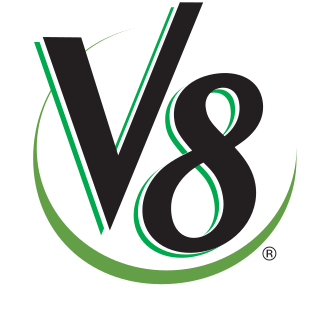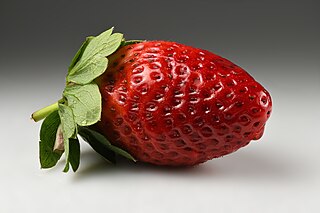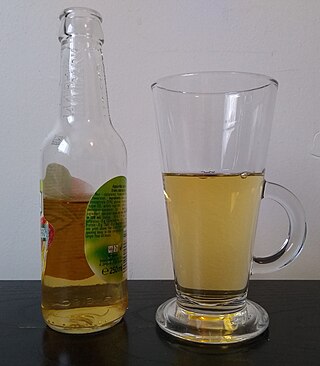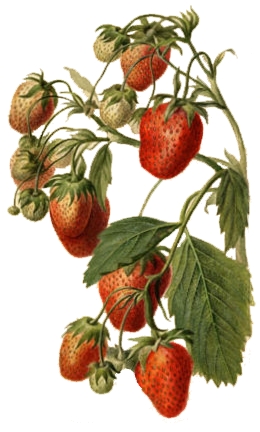
A berry is a small, pulpy, and often edible fruit. Typically, berries are juicy, rounded, brightly colored, sweet, sour or tart, and do not have a stone or pit, although many pips or seeds may be present. Common examples of berries in the culinary sense are strawberries, raspberries, blueberries, blackberries, white currants, blackcurrants, and redcurrants. In Britain, soft fruit is a horticultural term for such fruits.

Watsonville is a city in Santa Cruz County, California, in the Monterey Bay Area of the Central Coast of California. The population was 52,590 at the 2020 census. Predominantly Latino and Democratic, Watsonville is a self-designated sanctuary city.

Nutri-Grain is a brand of breakfast cereal and breakfast bar made by Kellanova. In Australia and New Zealand Nutri-Grain is a breakfast cereal made from corn, oats, and wheat. The pieces are shaped like bricks.

Starburst is the brand name of a box-shaped, fruit-flavoured soft taffy candy manufactured by The Wrigley Company, which is a subsidiary of Mars, Incorporated. Starburst has many different varieties, such as Tropical, Sour, FaveREDs, Watermelon, Very Berry, Superfruit, Summer Blast and Original.

V8 Vegetable Juice, sometimes simply referred to as V8, is a trademarked name for a number of beverage products sold worldwide that are made from eight vegetables, or a mixture of vegetables and fruits. Since 1948, the brand has been owned by the Campbell Soup Company.

Hawaiian Punch is an American brand of fruit punch currently manufactured by Keurig Dr Pepper, originally invented in 1934 by A.W. Leo, Tom Yeats, and Ralph Harrison as a topping for ice cream. It was started from an original syrup flavor called Leo's Hawaiian Punch, containing orange, pineapple, passion fruit, guava and papaya, and is currently offering 14 different flavors since 2020. Though earlier versions contained 10% fruit juice, the drink is currently made with 3% fruit juice.

The garden strawberry is a widely grown hybrid species of the genus Fragaria, collectively known as the strawberries, which are cultivated worldwide for their fruit. The fruit is widely appreciated for its characteristic aroma, bright red color, juicy texture, and sweetness. It is consumed in large quantities, either fresh or in such prepared foods as jam, juice, pies, ice cream, milkshakes, and chocolates. Artificial strawberry flavorings and aromas are also widely used in products such as candy, soap, lip gloss, perfume, and many others.

Hi-C is an American fruit juice-flavored drink made by the Minute Maid division of The Coca-Cola Company. It was created by Niles Foster in 1946 and released in 1947. The sole original flavor was orange.

Polar Beverages is a soft drink company based in Worcester, Massachusetts. It is a manufacturer and distributor of sparkling fruit beverages, seltzer, ginger ale, drink mixers, and spring water to customers in the United States. It is the largest independent soft-drink bottler in the United States.

Costa Group is Australia's largest horticultural company and a major supplier of produce to food retailers. The company had an IPO in 2015 and was officially listed on the Australian Securities Exchange.
Joseph Miles Reiter is an American farmer and entrepreneur, and the outgoing CEO of Driscoll's, Inc., a global agribusiness specializing in fresh year-round berry production.

Tymbark SA, is a Polish fruit- juice beverage company. Its products are mainly available in all of 16 Polish voivodeships as well as in most of Germany. Tymbark is also a fruit and vegetable processing plant. Tymbark is a major producer of fruit and vegetable juices as well as jams, marmalades and fruit wines. In 1999, the company became part of Grupa Maspex Wadowice. The Tymbark brand was listed as Poland's 15th most popular brand in a survey by Wprost magazine. It is known as Topjoy in Hungary or Relax in Czechia and Slovakia.

Bodyarmor SuperDrink is an American sports drink brand owned by The Coca-Cola Company. Products launched under the brand include: Sports, "Lyte" Sports, "Edge Sports," and "SportWater".

The following outline is provided as an overview of and topical guide to strawberries:

Mahabaleshwar strawberry is a strawberry grown in the hilly slopes of Mahabaleshwar, which accounts for about 85 percent of the total strawberry produced in India. Strawberry, along with raspberry, mulberry and gooseberry, is produced on a large scale in and around Mahabaleshwar. Mahabaleshwar strawberry obtained the geographical indication (GI) tag in 2010.
Banner was a variety of strawberry that grew in the northwestern United States in the early 1900s. The variety was originally named "Sweet Briar" by Thomas J. Loftus, who discovered the berry on his ranch just north of Redding, California.

Wish Farms is a Plant City, Florida based supplier of strawberries, blueberries, raspberries and blackberries. The company was established in 1922.

Berry-growing in Canada is mostly confined to its rainiest areas, although a lesser amount is grown elsewhere. Most berries are grown in southwest British Columbia, except lowbush blueberry which is almost only grown in The Maritimes. Significant amounts of strawberries are grown in southern Ontario, southern Quebec, and the southern part of the Maritimes, and smaller amounts around urban areas of the Prairies. Cranberry production has recently increased in BC and the east and as of 2016 is the second most exported berry by value at CAN$ 88,469,000. Blueberry is the most important, indeed top among all fruits in the country, by – cultivated area, 79,515 hectares – farm gate value, CAN$ 261,532,000 – and export value, CAN$ 422,441,000. Grape is third by – cultivated area, 12,480 hectares – and farm gate, CAN$ 151,093,000. Cherry is third in export value at CAN$ 82,841,000

Strawberries in the United States are almost entirely grown in California – 86% of fresh and 98% of frozen in 2017 – with Florida a distant second. Of that 30.0% was from Monterey, 28.6% from Ventura, 20.0% from Santa Barbara, 10.0% from San Luis Obispo, and 9.2% from Santa Cruz. The Watsonville/Salinas strawberry zone in Santa Cruz/Monterey, and the Oxnard zone in Ventura, contribute heavily to those concentrations.





















